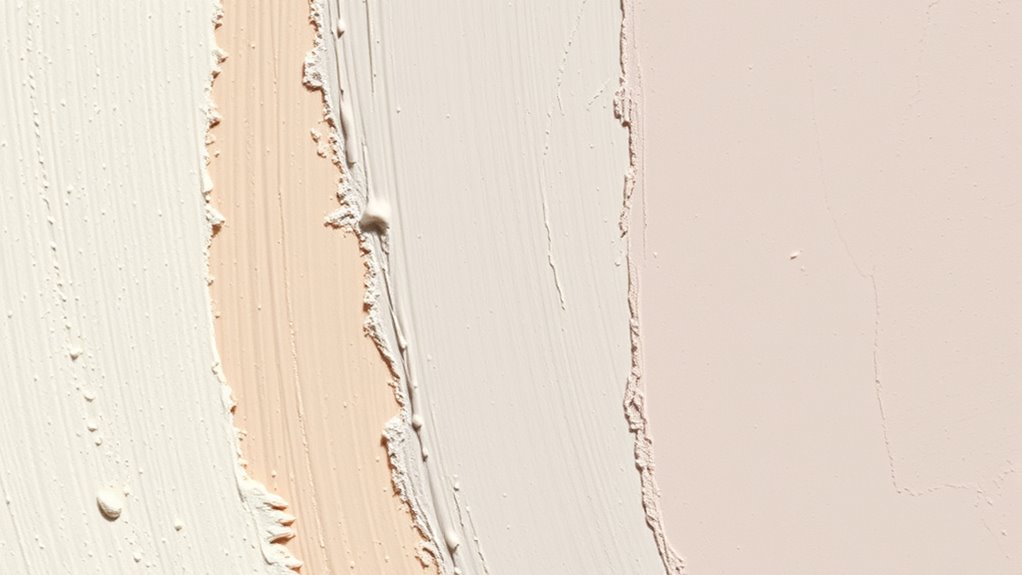Understanding undertones in paint colors helps you choose hues that set the right mood and stay beautiful over time. Recognize whether a color has warm undertones like yellow or red, or cool undertones like blue or green, by examining samples in different lighting. Your space’s atmosphere depends heavily on these subtle hints, so pay close attention to how lighting shifts the color. Keep exploring to master identifying undertones and make confident decorating decisions.
Key Takeaways
- Undertones are subtle hues that emerge beneath the main paint color, influencing mood and visual depth.
- Recognizing warm (yellow, orange, red) and cool (blue, green, purple) undertones helps in color selection.
- Lighting conditions, especially natural versus artificial light, significantly affect how undertones appear.
- Comparing paint samples in different lighting reveals true undertones and prevents mismatched choices.
- Understanding undertones guides harmonious interior design by matching decor and creating desired atmospheres.
What Are Undertones and Why Do They Matter?

Undertones are subtle hues that peek through the main color of a paint, giving it depth and character. Recognizing these undertones matters because they influence how a color affects the mood of a space through color psychology. For example, warm undertones can create a cozy, inviting atmosphere, while cool undertones evoke calmness. Additionally, understanding undertones helps you choose paint that maintains its appearance over time, as certain undertones can enhance paint durability and resist fading. When selecting a color, looking closely at undertones ensures you get a shade that aligns with your style and the room’s purpose. Paying attention to undertones ultimately leads to a more harmonious, long-lasting finish that complements your space perfectly. Unique and wicked planters can also be used to highlight and complement undertones in interior decor.
Recognizing Warm and Cool Undertones in Paint Colors
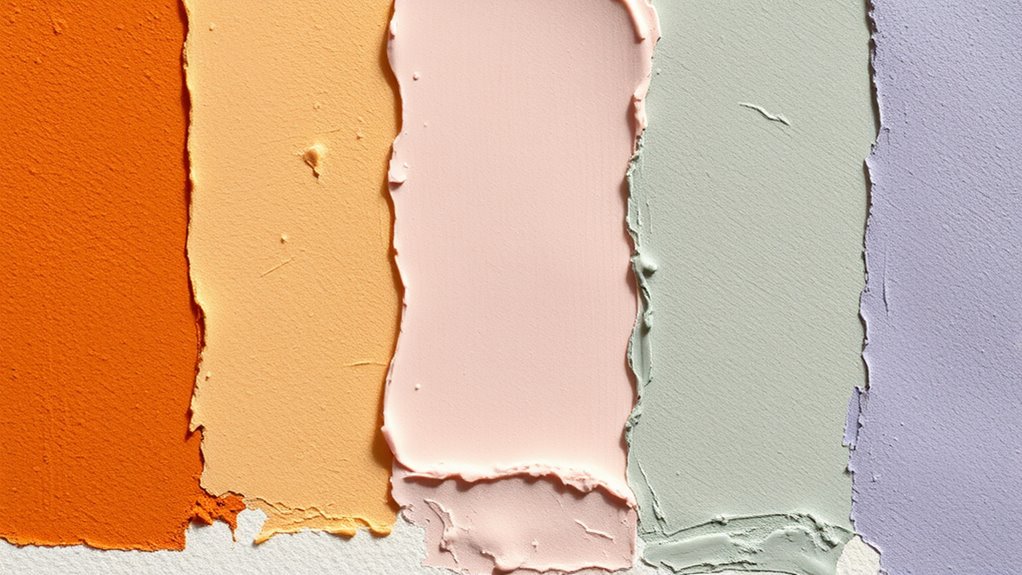
When trying to identify whether a paint color has warm or cool undertones, start by observing its subtle hints of color in different lighting conditions. Warm undertones often appear more yellow, orange, or red, while cool undertones lean toward blue, green, or purple. Pay attention to how the color interacts with other shades through color mixing; warm tones tend to energize a space, creating a cozy, inviting atmosphere, whereas cool tones promote calmness and serenity. Recognizing these undertones helps you select colors that enhance your mood and complement your existing décor. By carefully analyzing these subtle hints and how they shift under various lighting, you can confidently choose paint colors that align with your desired ambiance and aesthetic. Additionally, understanding color temperature can improve your ability to select harmonious hues for any room.
How to Identify Undertones in Different Lighting Conditions
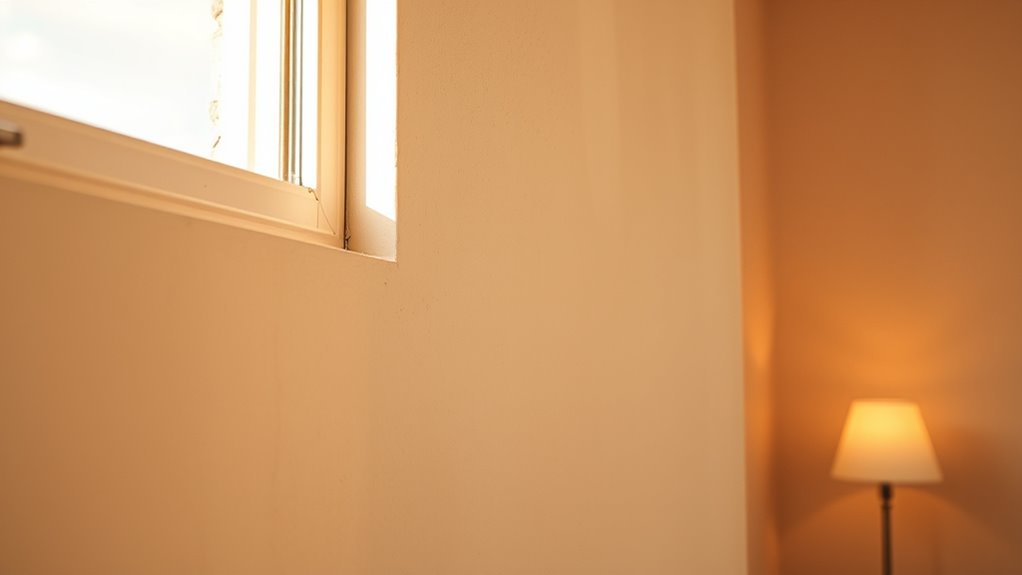
To accurately identify undertones, start by observing your paint sample in natural light, as it reveals true colors. Next, place a white background behind the swatch to see subtle shifts more clearly. Finally, compare how the color looks in different settings to guarantee you understand its true undertone across various lighting conditions. Paying attention to air quality indicators can also help determine if the lighting environment affects your perception of the color.
Observe Under Natural Light
Natural light reveals the true nature of a paint color more accurately than any artificial lighting. When observing, do so near a window or outdoors to see the color’s true undertones. Natural light can make warm tones appear more vibrant or cool shades seem softer. Use a color wheel to compare colors and identify subtle undertones as daylight shifts. Shade matching under natural light helps you distinguish whether a hue leans toward pink, green, or yellow. Make sure to check the color at different times of day, since sunlight changes throughout the day and can alter how undertones appear. Additionally, understanding the concept of color temperature can help you anticipate how the color might look in various lighting conditions. By consistently observing under natural light, you gain a clearer understanding of how the paint will look in your space, helping you choose the perfect shade with confidence.
Use a White Background
Using a white background can be a simple yet effective way to spot undertones in different lighting conditions. It provides a neutral surface that reveals subtle color shifts caused by lighting and color temperature. When evaluating paint colors against white, observe how the hue changes throughout the day and under various lights. This method helps you see if the undertones lean warm, cool, or neutral, which can influence the overall mood of a room. Here’s a quick reference:
| Lighting Condition | Color Temperature | Mood Influence |
|---|---|---|
| Morning sunlight | Warm (yellow) | Cozy, inviting |
| Overcast | Cool (blue) | Calm, serene |
| Artificial light | Varies | Alters ambiance |
This approach guarantees you select a color that maintains its intended feel in every setting. Incorporating color accuracy considerations can further enhance your ability to choose the perfect hue for your space.
Compare in Multiple Settings
Comparing paint colors in different lighting conditions is essential for accurately identifying their undertones. Natural light, artificial lighting, and time of day can all influence how a color appears, affecting your perception of its warmth or coolness. By observing your chosen paint in various settings, you better understand its true hue and undertones, guaranteeing it complements your space. Remember, color psychology plays a role—certain undertones evoke specific moods—while paint durability ensures the color maintains its integrity over time. Additionally, understanding PlayStation support hours can help you troubleshoot any issues with digital tools used in your decorating process. Recognize how lighting shifts reveal subtle undertones, helping you select the right hue. Consider the impact of color psychology on the mood your space will evoke. Assess how lighting affects paint durability and appearance, ensuring longevity and satisfaction.
The Impact of Undertones on Room Atmosphere and Decor
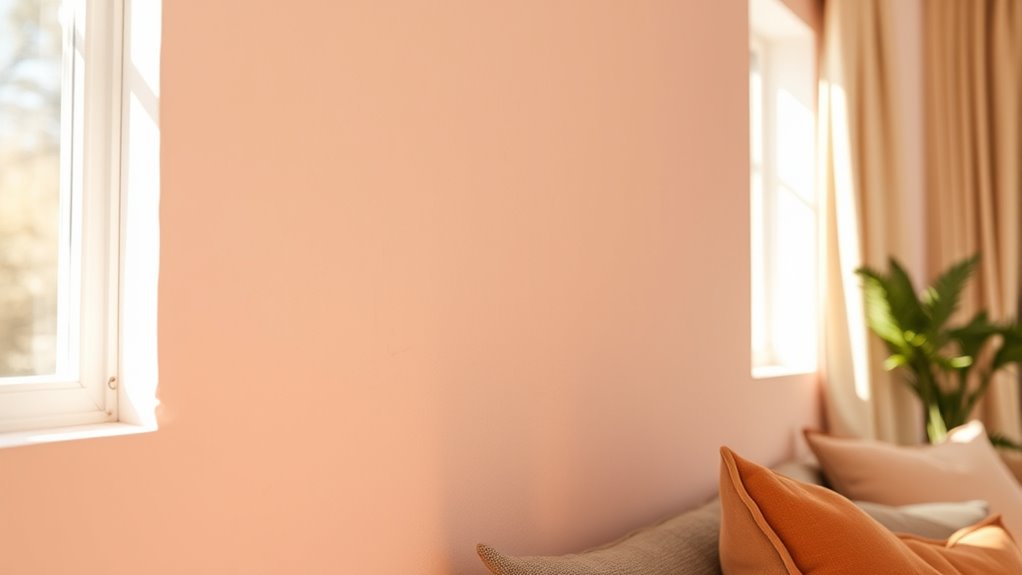
Undertones in paint colors play a crucial role in shaping the atmosphere of a room and influencing its overall decor. Your choice of undertone can evoke specific emotions through color psychology, affecting how you feel in the space. For example, warm undertones like yellow or red can create a cozy, inviting vibe, perfect for living rooms or bedrooms. Cool undertones such as blue or green foster calmness and serenity, ideal for offices or bathrooms. The undertone also guides your interior styling, helping you select complementary decor and accessories. When you understand how undertones impact mood and aesthetic, you can craft a cohesive environment that reflects your personality and enhances the room’s purpose. Additionally, recognizing subtle color variations like undertones enables you to choose paints that maintain consistency over time, even if lighting conditions change. Essentially, undertones are a subtle yet powerful tool in transforming your space.
Tips for Choosing the Right Undertone for Your Space
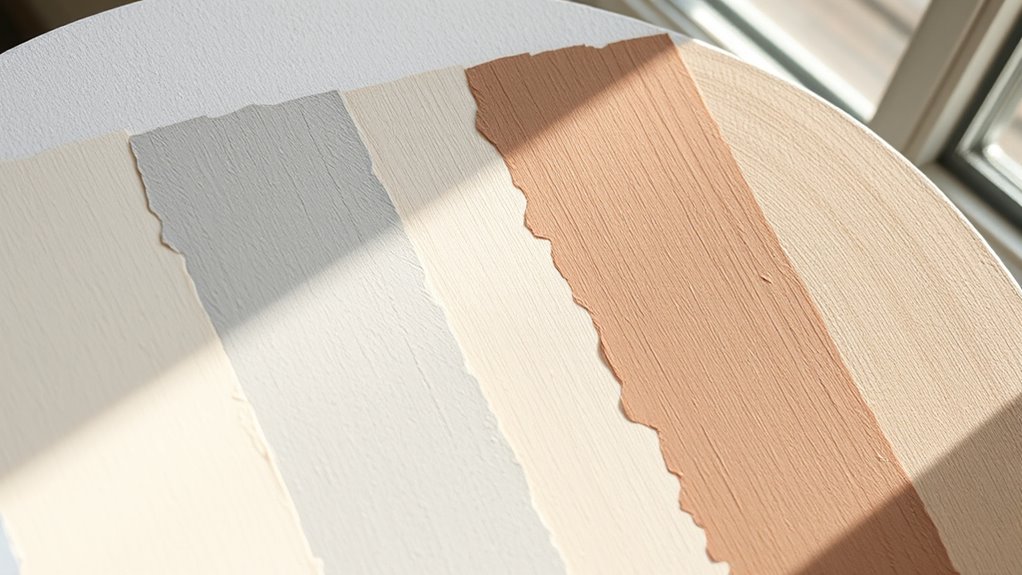
Choosing the right undertone for your space starts with considering the room’s purpose and the mood you want to create. Think about how color psychology influences feelings—calming blues or energizing reds can set the tone. When selecting paint, explore finish options like matte, satin, or semi-gloss, as they can enhance or mute undertones. To guarantee you pick the perfect hue:
Choosing the right undertone sets the mood and enhances your space’s atmosphere effectively.
- Test paint samples in different lighting conditions to see how undertones shift.
- Choose undertones that complement existing furniture and decor.
- Balance bold undertones with neutral finishes for versatility.
Pay attention to how undertones interact with natural light, as this can dramatically change their appearance throughout the day. Being mindful of these factors helps you confidently select colors that truly enhance your space’s atmosphere, especially considering that lighting conditions can significantly influence how undertones appear in your room.
Common Mistakes When Picking Paint Colors With Hidden Undertones
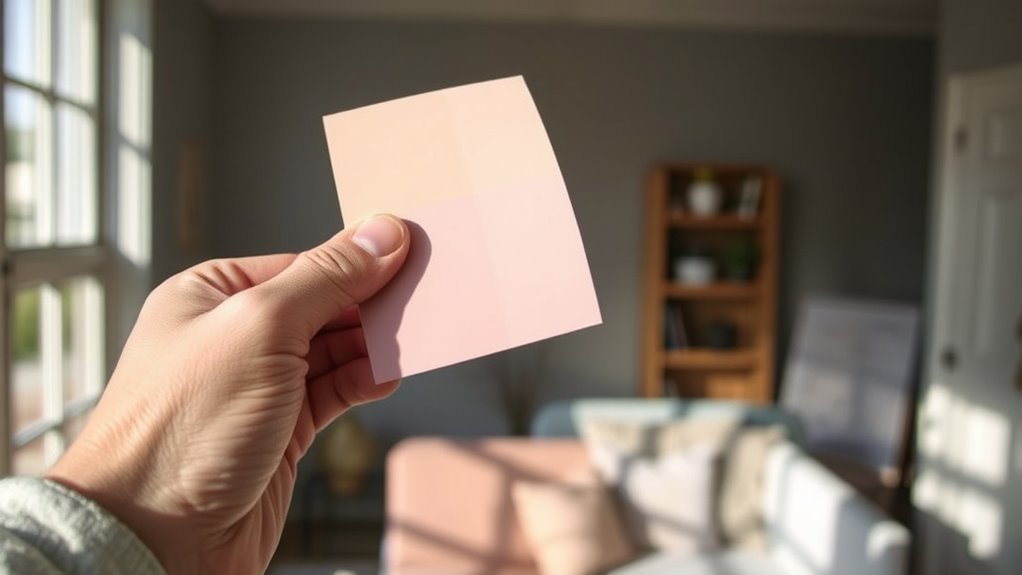
One common mistake people make is overlooking how lighting conditions can reveal or hide hidden undertones, leading to unexpected color shifts that clash with your color psychology intentions. You might choose a hue based on its appearance in store lighting, but natural light can bring out subtle undertones that change the room’s mood. Additionally, focusing solely on color psychology without considering paint durability can be problematic; certain undertones may fade or become dull over time, altering the intended effect. Not testing paint in different lighting or ignoring how undertones interact with your space’s natural environment often results in colors that don’t match your vision. To avoid this, evaluate samples thoroughly and consider how lighting impacts undertones throughout the day. Being aware of paint performance and how it interacts with undertones can help you select colors that stay true over time.
Using Sample Paint Swatches to Detect Undertones
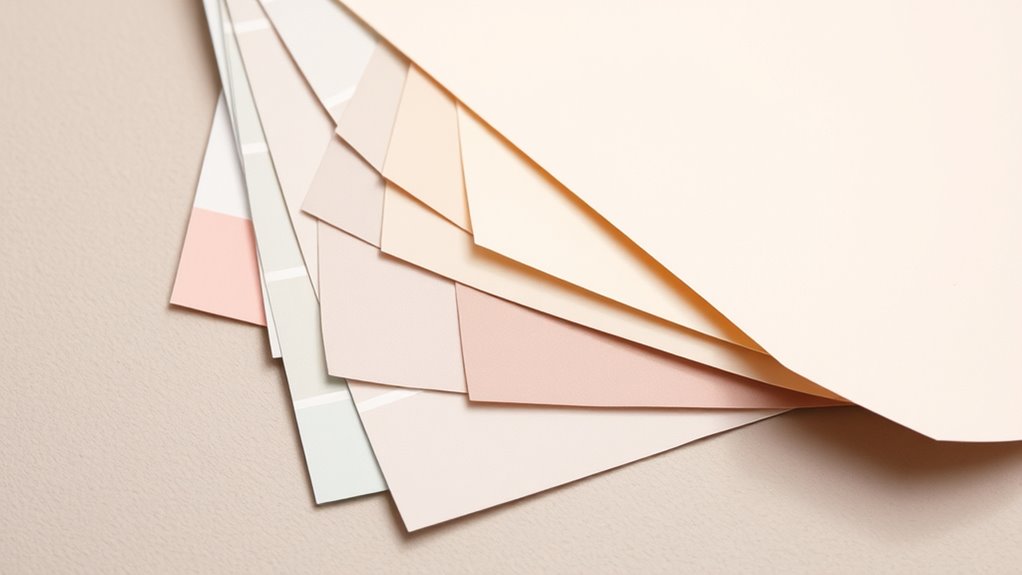
When you compare different paint swatches, look closely at how they vary in color under the same lighting. Pay attention to subtle differences that reveal underlying hues, like a hint of green or pink. Recognizing these variations helps you identify the true undertone before making a final choice. Being aware of cookie usage can also enhance your browsing experience as you research different paint options.
Comparing Swatch Variations
Comparing swatch variations is an essential step in accurately detecting undertones in paint colors. You should observe how the color appears in different lighting, paying attention to subtle shifts. Look for consistency in hue and note any variations caused by changes in color temperature or paint consistency. These differences can reveal hidden undertones that might not be obvious at first glance. Additionally, understanding the rustic decor aspect of farmhouse bedrooms can help you choose paint colors that complement natural materials and vintage accents.
Identifying Underlying Hues
Using sample paint swatches is a practical way to identify underlying hues that reveal undertones. Hold the swatches in different lighting conditions—natural daylight, warm indoor lights, or fluorescent lighting—to see how lighting effects influence the colors. Pay attention to subtle shifts in hue; for example, a beige might reveal hints of pink or green. Understanding color psychology helps you recognize how these undertones can affect the mood of a space. Comparing swatches side-by-side allows you to detect faint tints that might go unnoticed otherwise. This process helps you choose a color that complements your room’s lighting and desired atmosphere. Accurate identification of underlying hues ensures your final paint choice aligns with your vision, creating a harmonious environment. Additionally, being aware of AI integration in mobile devices can help you explore innovative tools for virtual color visualization, making your selection process even more precise.
Expert Advice for Navigating Undertones in Color Selection

Navigating undertones in paint colors can be tricky, but understanding how they influence the overall look makes the process easier. When selecting colors, consider how undertones affect the room’s mood through color psychology—warm tones create coziness, while cool shades promote calm. It’s also essential to explore different paint finish options; matte finishes can soften undertones, while glossy finishes highlight them. To make confident choices, keep these tips in mind:
- Test paint samples in various lighting to see true undertones
- Use color swatches to compare undertones side-by-side
- Consult with professionals for expert advice tailored to your space
Mastering undertones allows you to pick shades that enhance your décor and mood, ensuring your space feels just right.
Frequently Asked Questions
How Do Undertones Influence Overall Room Design and Mood?
Undertones considerably influence your room’s design and mood by shaping color harmony and emotional impact. Warm undertones create inviting, energetic spaces, while cool undertones promote calmness and relaxation. When choosing paint, consider how undertones blend with furniture and decor to evoke the desired atmosphere. By selecting colors with the right undertones, you guarantee your room feels cohesive and aligned with the mood you want to foster.
Can Undertones Affect the Perceived Size of a Room?
Think of undertones as the room’s silent storyteller, subtly shaping your perception. They can make a space feel larger or cozier by influencing light reflection and color perception. Cooler undertones tend to expand a room, reflecting more light, while warmer ones can create intimacy, making it feel smaller. By choosing the right undertones, you control how your space interacts with light, ultimately affecting its perceived size and ambiance.
Are There Universal Undertones That Suit All Interior Styles?
There aren’t universal undertones that suit all interior styles, but you can find versatile options through careful color matching and paint selection. Warm undertones like beige or taupe often complement traditional or rustic spaces, while cool undertones such as gray or blue work well in modern or minimalist designs. Focus on choosing undertones that align with your overall aesthetic, and test paint samples to see how they interact with your room’s lighting.
How Do Undertones Interact With Different Furniture Finishes?
Think of undertones as the secret language between your paint and furniture. When you choose furniture finishes, they act like characters in a story, interacting with your paint’s undertones. Complimentary palettes create harmony, while contrasting hues add drama. If your furniture has warm finishes, choose paint with warm undertones to match. Conversely, cool-toned furniture pairs well with paint that has cool undertones, making everything feel balanced and intentional.
What Tools or Apps Can Help Identify Undertones Accurately?
You can use digital color analyzers or color matching apps to identify undertones accurately. These tools scan and analyze paint colors, helping you see subtle undertones that might be difficult to detect with the naked eye. By leveraging technology, you guarantee precise color matching, making it easier to coordinate paint colors with your furniture and decor. Try apps like ColorSnap or ColorSmart for reliable results and confident color choices.
Conclusion
Understanding undertones isn’t just about color theory; it can genuinely transform your space. Many believe that choosing the perfect hue is all about matching preferences, but considering undertones guarantees your room feels cohesive and inviting. Trust your instincts and test samples in different lighting. When you pay attention to undertones, you might find that your dream room becomes a stunning reality—sometimes, the smallest details make the biggest difference.

